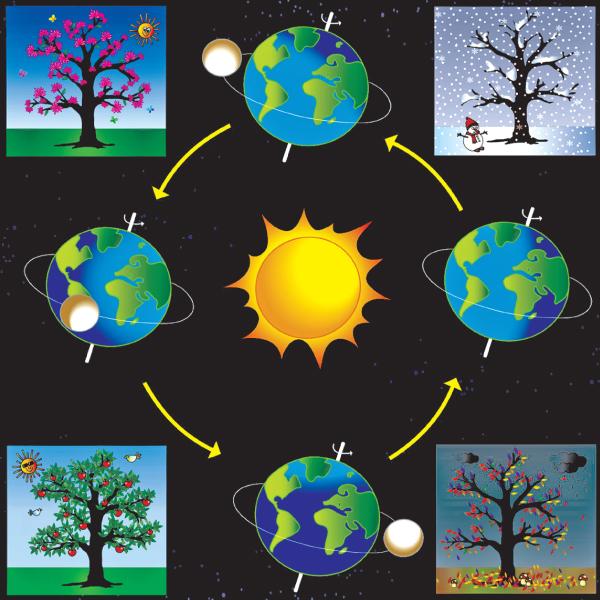
 We divide up the year into four seasons: spring, summer, autumn, and winter. Each season lasts 3 months with summer being the warmest season, winter being the coldest, and spring and autumn lying in between.
We divide up the year into four seasons: spring, summer, autumn, and winter. Each season lasts 3 months with summer being the warmest season, winter being the coldest, and spring and autumn lying in between.
The seasons have a lot of impact on what happens on the earth. In the spring, animals are born and plants come back to life.
Summer is hot and is when kids are usually out of school and we take vacations to the beach.
Often crops are harvested at the end of the summer. In autumn the leaves change colors and fall off the trees and school starts again.
Winter is cold and it snows in many places. Some animals, like bears, hibernate in the winter while other animals, like birds, migrate to warmer climates.
Why do seasons occur?
Seasons are caused because of the Earth's changing relationship to the Sun. The Earth travels around the Sun, called an orbit, once a year or every 365 days. As the Earth orbits the Sun the amount of sunlight each place on the planet gets every day changes slightly. This change causes the seasons.
The Earth is Tilted
Not only does the Earth rotate around the Sun every year, but the Earth spins in a circle every 24 hours. This is what we call a day.
However, the Earth doesn't spin in a straight up and down manner relative to the Sun. We are slightly tilted. In scientific terms, we are tilted 23.5 degrees from our orbital plane with the Sun.
The Earth is Tilted
In the Northern Hemisphere the longest day is on June 21st while the longest night is on December 21st. It's just the opposite in the Southern Hemisphere where the longest day is December 21st and the longest night is June 21st. There are two days a year where the day and night is exactly the same. These are September 22nd and March 21st.
Why does our tilt matter?
The tilt has two major effects: the angle of the Sun to the earth and length of the days. For half of the year the Earth is tilted such that the North Pole is more pointed towards the Sun. For the other half the South Pole is pointed at the Sun. When the North Pole is angled toward the Sun, the days on the northern part of the planet (north of the equator) get more sunlight or longer days and shorter nights. With longer days the northern hemisphere heats up and gets summer. As the year progresses, the Earth's tilt changes to where the North Pole is pointing away from the Sun producing winter.
For this reason, seasons north of the Equator are the opposite of seasons south of the Equator. When it's winter in Europe and the United States, it will be summer in Brazil and Australia.
We talked about the length of the day changing, but the angle of the Sun changes as well. In summer the sunlight shines more directly on the earth giving more energy to the Earth's surface and heating it up. During the winter the sunlight hits the Earth at an angle. This gives less energy and doesn't heat the Earth as much.
